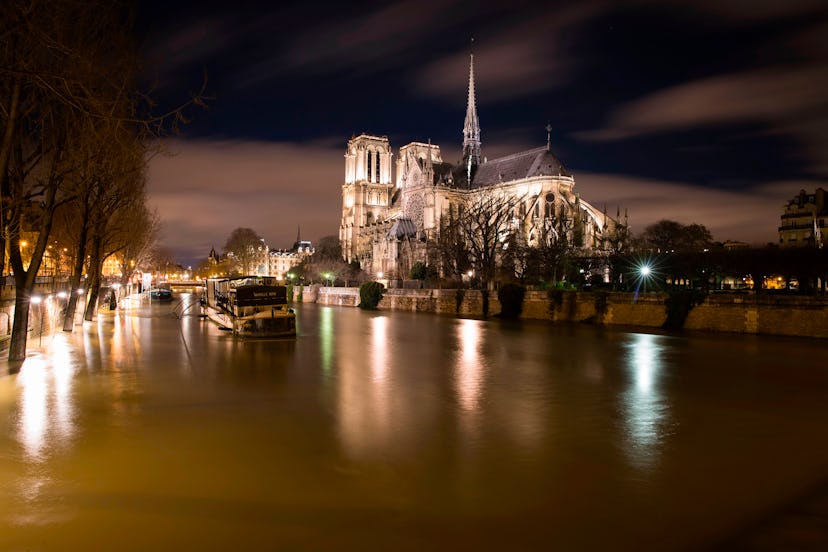Notre Dame Has Been Everything From a Honeybee Home to a Pagan Temple

It’s no wonder that less than 12 hours after the Notre Dame caught fire on Monday, billionaires are already clamoring to contribute to its restoration. The cathedral is not only one of Paris’s most beloved landmarks, but a paradigm of Gothic architecture—and one that dates back to the 1100s at that.
Fret not: Notre Dame has since been declared “structurally sound.” (After all, it’s survived much more than that before, from decades of neglect—at least until Victor Hugo came to its rescue—to Adolf Hitler’s threat of demolition.) Now that it’s thankfully here to stay, study up on some of the lesser-known reasons as to why the cathedral has come to be regarded as a national—and international—treasure.
It started off as a center for paganism.
Construction on the cathedral began in 1163, though it didn’t wrap up until long after; while the towers were completed in 1245, it wasn’t until the 19th century that it got its central spire. But Parisians weren’t the only ones to transform where it stands on the Île de la Cité: It was first home to a pagan temple, which Romans built after Julius Caesar led them to occupy the city in 52 BC.
It’s the literal center of Paris.
It might be tricky to find amidst all the tourists, but the concrete outside the cathedral features a brass plate that marks Paris’s “point zero,” or the city’s supposed center. Of course, it’s a center in other ways, too: The Eiffel Tower may have taken over its towers’ title of the city’s tallest structure in the 1930s, but Notre Dame still receives nearly double the number of visitors.
A view of Paris from the roof of the Notre Dame cathedral in Paris, August 2007.
No one really cared about it before Victor Hugo.
It was only after Victor Hugo wrote and published The Hunchback of Notre Dame in 1831 that the cathedral returned to the public’s attention. (It had, after all, been looking a bit worse for wear, thanks to a renovation by Louis XIV, who replaced its stained glass with clear windows, and the French Revolution.) It also returned to the attention of public officials, who promptly kicked things into high gear, reversing the previous centuries of neglect just a decade after Hugo’s book was published.
It’s home to a thriving community of altruistic honeybees.
Along with landmarks like the Opera Garnier, the roof of Notre Dame has proven quite amenable to beehives. But unlike the Opera Garnier, which sells itsr honey in its gift shop, Notre Dame’s beekeepers make sure theirs end up in the hands of the poor.
The base of the spire of Notre Dame cathedral in Paris.
It’s also home to Jesus’s Crown of Thorns.
A piece of the crown that Jesus is thought to have worn when he was crucified, a nail, and a piece of the cross are some of the most prominent relics that can be found inside Notre Dame. (Or outside: In 1935, an archbishop placed several of Notre Dame’s relic, including the fragment of the crown, at the very top of the building’s spire, in hopes that it would offer it protection.)
Inside of the Notre Dame cathedral in Paris.
The South Rose of Notre Dame cathedral in Paris.
Its bells were once turned into cannons.
As one of the city’s most prominent symbols of the church and monarchy, Notre Dame wasn’t too popular during the French Revolution—at least until they realized its potential for ammunition. Lead from the cathedral’s roof was then turned into bullets, and all but one of its enormous bells were melted down and turned into cannons. (The sole survivor was Emmanuel, which weighs 13 tons.)
It’s full of homages to a beheaded saint.
Whether or not Saint Denis actually did manage to walk six kilometers after being beheaded, bringing his head along for the trek, traces of the martyr can be found throughout Notre Dame, from a statue on its façade to a section of its stained glass.
A statue of St. Denis holding his head surrounded by statues of angels on the left doorjamb of the Portal of the Virgin, on the western façade of Notre Dame cathedral in Paris.
Head-related drama is still haunting it today.
The French Revolution brought Saint Denis quite a bit of headless company. No fewer than 28 statues lost their heads to a crowd that mistook them for French kings. (They were actually likenesses of ancient leaders of Israel and Judea.) As it turned out some two centuries later, though, they still had some life in them yet: 21 of the heads, which were sculpted in the early 1200s, were discovered inside the wall of a building in an entirely different neighborhood of Paris in the 1970s.
Related: Everything We Know So Far About the Notre Dame Fire